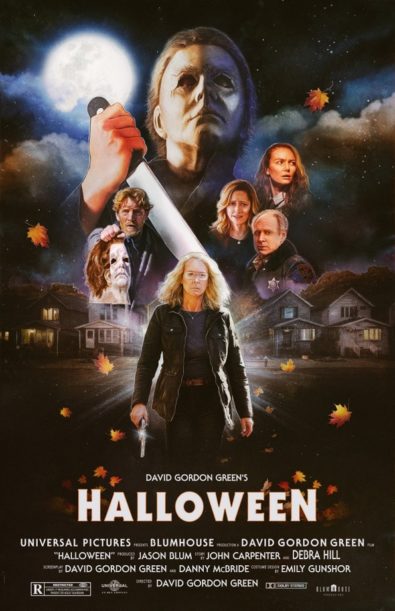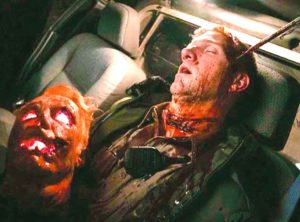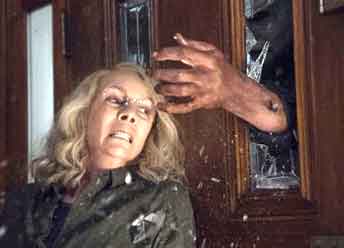 In this 2018 film, Hollywood’s war on originality reached new heights. It was the second attempt at rebooting John Carpenter’s 1978 classic HALLOWEEN, following Rob Zombie’s 2007 version, which was a “straight” reboot (or, more accurately, remake). This newer version takes a different approach, serving as both a reboot and a sequel—and so providing a “retroactive continuity” (or “retcon”)—to Carpenter’s HALLOWEEN, which Zombie’s version (and its 2009 follow-up) ignored along with the original film’s numerous sequels.
In this 2018 film, Hollywood’s war on originality reached new heights. It was the second attempt at rebooting John Carpenter’s 1978 classic HALLOWEEN, following Rob Zombie’s 2007 version, which was a “straight” reboot (or, more accurately, remake). This newer version takes a different approach, serving as both a reboot and a sequel—and so providing a “retroactive continuity” (or “retcon”)—to Carpenter’s HALLOWEEN, which Zombie’s version (and its 2009 follow-up) ignored along with the original film’s numerous sequels.
Among those sequels was 1998’s HALLOWEEN H2O, which provided the template for this new HALLOWEEN. H2O, as you may recall, had the original film’s star Jamie Lee Curtis as ex-babysitter Laurie Strode returning (after sitting out installments 3 – 6) for what was promised as a “final confrontation” with The Shape, a.k.a. Michael Meyers, with a very late nineties (i.e. SCREAM-inspired) overlay courtesy of screenwriter Kevin Williamson, who did an extensive (uncredited) script rewrite.
The 2018 HALLOWEEN, co-produced by Malek Akkad (the son of HALLOWEEN’S late executive producer Moustapha Akkad) and directed by independent film stalwart David Gordon Green (who previously stated a desire to remake Dario Argento’s SUSPIRIA), had essentially the same premise. Curtis is back, as is Nick Castle, who portrayed Michael Myers in the first HALLOWEEN (here trading off acting duties with longtime stuntman James Jude Courtney), with the film affecting a supposedly more 2010s friendly, #MeToo era vibe.
In truth, though, the film, with its staunchly pro-self-defense, vigilante minded air, is extremely right wing in its orientation. It was anointed by the National Review, which (accurately) proclaimed it “a gung-ho, gun-loving, liberal-trolling, capital-punishment-backing conservative manifesto in the format of a slasher flick” (that’s even more true, FYI, of this film’s 2021 sequel HALLOWEEN KILLS, which in addition to those things promotes mob justice). It was, in any event, a surprise hit, grossing $255 million against a $10 million budget, thus making it the most lucrative slasher movie in history.
“a gung-ho, gun-loving, liberal-trolling, capital-punishment-backing conservative manifesto in the format of a slasher flick”…
“The world is not a dark and evil place,” it being apparently “full of love and understanding!” So claims Karen, the fortyish daughter of the elderly Laurie Strode, a self-described basket case (thus granting Curtis’ unfulfilled wish for HALLOWEEN H2O: for Laurie’s post-HALLOWEEN life to be “a mess”). Karen is wrong, of course, as Michael Myers has escaped from the mental institution where he was interred via a bus crash (if Hollywood has taught us anything it’s that any time a bus is seen transporting convicts or mental patients it won’t stay upright for very long). Laurie is delighted, having prayed daily for Michael to escape so she can kill him.
…Curtis’ unfulfilled wish for HALLOWEEN H2O: for Laurie’s post-HALLOWEEN life to be “a mess”…
After offing a pair of nosy reporters wanting to do a story on him, Michael dons the William Shatner mask he initially wore and heads back to Haddonfield, IL (actually LA County, CA). There he resumes the babysitter killing spree he commenced in ’78, with Laurie’s teenage granddaughter among his prospective victims. The police prove ineffectual, as do the psychiatrists (with the former spending more time arguing about the merits of convenience store pastries and the latter more interested in writing dissertations on Michael Myers than in stopping him), leaving Laurie and Karen, who Laurie has brought up Sarah Conner style, to take him on by themselves. Karen has until now resisted her mother’s teachings, but when Myers reaches their house she finds her childhood education in self-reliance and firearms resurfacing.
Jamie Lee Curtis is back, as is Nick Castle, who portrayed Michael Myers in the first HALLOWEEN (here trading off acting duties with longtime stuntman James Jude Courtney), with the film affecting a supposedly more 2010s friendly, #MeToo era vibe.
 In this film David Gordon Green does his best to replicate John Carpenter’s methodical Panaglide visuals in lengthy Steadicam POV shots (the Steadicam having replaced the Panaglide as the industry standard for movie tracking shots). Green’s arty sensibilities, alas, don’t jibe with those of Carpenter, who if nothing else definitely understood the mechanics of horror moviemaking. Green seems most interested in multicolored filters, varying sound levels and handheld camerawork, things quite redolent of the independent films in which Green made his mark that don’t quite work in a horror/splatter movie context.
In this film David Gordon Green does his best to replicate John Carpenter’s methodical Panaglide visuals in lengthy Steadicam POV shots (the Steadicam having replaced the Panaglide as the industry standard for movie tracking shots). Green’s arty sensibilities, alas, don’t jibe with those of Carpenter, who if nothing else definitely understood the mechanics of horror moviemaking. Green seems most interested in multicolored filters, varying sound levels and handheld camerawork, things quite redolent of the independent films in which Green made his mark that don’t quite work in a horror/splatter movie context.
John Carpenter himself, in collaboration with his son Cody and Daniel A. Davies, did the music, which consists mostly of recycled cues from the original HALLOWEEN score. Thus this HALLOWEEN is never as artful, nor as satisfying, as it should have been given the impressive roster of talents—Carpenter, Green, Curtis—that assisted in its creation. My advice? See the original and definitive HALLOWEEN, and also its 1981 sequel, which isn’t very good but is still vastly superior to the present film.
Vital Statistics
HALLOWEEN
Universal Pictures/Blumhouse
Director: David Gordon Green
Producers: Malek Akkad, Bill Block, Jason Blum
Screenplay: Jeff Fradley, Danny McBride, David Gordon Green
Cinematography: Michael Simmonds
Editing: Timothy Alverson
Cast: Jamie Lee Curtis, Judy Greer, Andi Matichak, James Jude Courtney, Nick Castle, Haluk Bilginer, Will Patton, Rhian Rees, Jefferson Hall, Toby Huss, Virginia Gardner, Dylan Arnold, Miles Robbins, Drew Scheid, Jibrael Nantambu, Michael Harrity, William Matthew Anderson, Diva Tyler, Bien Gregorie, Vince Mattis, Omar Dorsey, Pedro Lopez, Charlie Benton, Christopher Nelson, Teresa Ann Johnson, Jonathan Bruce, Charlie Donadio, Stephanie Butts

